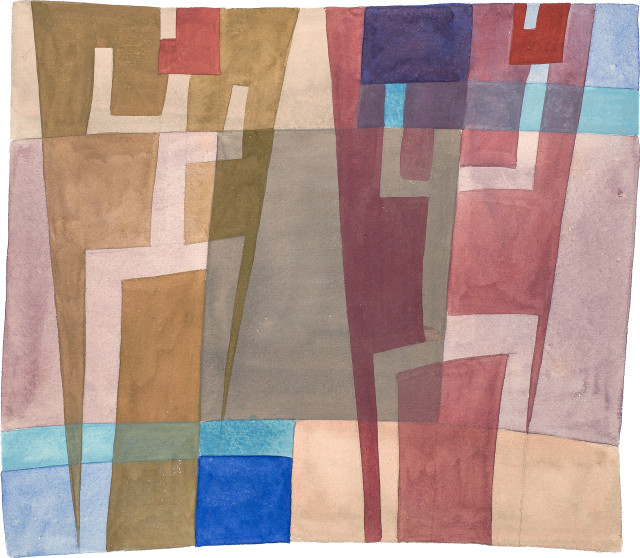- FR
S’inscrire
- Acheter
- Vendre
- Plus
- Galerie
- Commerce d'art
- Maison d'Édition
- Kornfeld aujourd’hui
- L'histoire de la Maison
- Informations






Davos 1889 - 1943 Zürich
1927
Gouache over preliminary drawing in pencil
24.5x33 cm
Signed in ink on the reverse by the artist and inscribed "S H Arp Taeuber Zürich". On the reverse with the artist's estate stamp and the work number 1927/9
Georg Schmidt/Hugo Weber, Sophie Taeuber-Arp, Catalogue de l'œuvre, Basel 1948, no. 1927/9
Estate of the artist
Gift to private collection Switzerland
Strasbourg 1977, Musées de la ville de Strasbourg, cat. no. 66
Winterthur 1977, Kunstmuseum, Sophie Taeuber-Arp, cat. no. 62, reprod., label on the reverse
Solothurn 2002/2003, Kunstmuseum, Sophie Taeuber-Arp: works on paper, plate 14 reprod.
Davos/Rolandseck 2009/2010, Kirchner Museum/Arp Museum, Sophie Taeuber-Arp, Bewegung und Gleichgewicht, cat. no. 59, reprod.
Paris 2011/2012, Centre Pompidou, Danser sa vie, pag. 308, reprod.
Basel/London/New York 2021/2022, Kunstmuseum/Tate Modern/Moma, Sophie Taeuber-Arp, cat. no. 147, pag. 134 reprod.
On strong, yellowish wove paper (papier vélin). A few spots. Colour fresh and in impeccable overall condition
Sophie Henriette Gertrud Taeuber-Arp is considered a pioneer of modernism. It was above all the joy of experimentation in the avant-garde circles of Zurich and Paris, which she joined, that allowed her to develop her impressive form of "applied" abstraction
The artist's paintings and sculptures, as well as her architectural sculptures or handicraft works, belong to the realm of concrete, constructive art. Vertical-horizontal compositions of geometric forms characterise her work. The figures, which were clearly recognisable in the beginning, disappeared from her paintings and reliefs over time. The deliberately simple means of design seek a floating, dancing, moving balance of colours and forms
From May 1916 Sophie Taeuber was appointed head of the textile class at the Zurich School of Arts and Crafts. She taught there until 1929 with the aim of exploring and even dissolving the boundaries between artistic genres. It is therefore not surprising that in 1915, alongside her work as a visual artist, she began training in dance with Rudolf von Laban and his assistant Mary Wigman. During several summers she danced with Laban's troupe on the "Monte Verità" above Ascona. At the "Cabaret Voltaire", which opened on 5 February 1916, she performed several times as an expressive dancer as part of DADA Zurich, for example at the opening of the "Galerie Dada" founded by Emmy Hennings in March 1917, where she danced to verses by Hugo Ball in a shamanic mask by Marcel Janco
Works of visual art in which the interest and passion for dance can be read are extremely rare in the oeuvre; the gouache offered here is one of these special works. It is an extremely charming representation of the theme, radically realised on the border to abstraction. The moment of movement oscillates in the elegantly constructed colour space. A wonderful example of the artist's compositional power
1927
Gouache über Vorzeichnung in Bleistift
24,5x33 cm
Rückseitig von der Künstlerin in Feder in Tinte signiert und bezeichnet "S H Arp Taeuber Zürich". Rückseitig mit dem Nachlassstempel der Künstlerin und der Werknummer 1927/9
Georg Schmidt/Hugo Weber, Sophie Taeuber-Arp, Catalogue de l'œuvre, Basel 1948,
Nachlass der Künstlerin
Geschenk an Privatsammlung Schweiz
Strasbourg 1977, Musées de la ville de Strasbourg,
Winterthur 1977, Kunstmuseum, Sophie Taeuber-Arp,
Solothurn 2002/2003, Kunstmuseum, Sophie Taeuber-Arp: Arbeiten auf Papier, Tafel 14 reprod.
Davos/Rolandseck 2009/2010, Kirchner Museum/Arp Museum, Sophie Taeuber-Arp, Bewegung und Gleichgewicht,
Paris 2011/2012, Centre Pompidou, Danser sa vie, pag. 308, reprod.
Basel/London/New York 2021/2022, Kunstmuseum/Tate Modern/Moma, Sophie Taeuber-Arp,
Auf festem, gelblichem Velin. Vereinzelte Fleckchen. Farbfrisch und in tadelloser Gesamterhaltung
Sophie Henriette Gertrud Taeuber-Arp gilt als eine Pionierin der Moderne. Es war vor allem die Experimentierfreude der Avantgarde-Zirkel von Zürich und Paris, denen sie sich anschloss, die sie ihre eindrückliche Form von "angewandter" Abstraktion entwickeln liess
Die Bilder und Plastiken der Künstlerin sowie ihre Bauskulpturen oder kunsthandwerklichen Arbeiten gehören zur konkreten, konstruktiven Kunst. Vertikal-horizontale Kompositionen aus geometrischen Formen prägen ihr Werk. Die anfangs noch klar erkennbaren Figuren verschwanden mit der Zeit aus ihren Bildern und Reliefs. Die bewusst einfach gehaltenen Gestaltungsmittel suchen ein schwebendes, tänzerisch-bewegtes Gleichgewicht von Farben und Formen
Ab Mai 1916 wurde Sophie Taeuber mit der Leitung der Textilklasse an der Zürcher Kunstgewerbeschule beauftragt. Bis 1929 unterrichtete sie dort mit dem Ziel, die Grenzen zwischen den künstlerischen Gattungen auszuloten und gar aufzuheben. So erstaunt es nicht, dass sie neben ihrer Arbeit als bildende Künstlerin 1915 eine Tanzausbildung bei Rudolf von Laban und seiner Assistentin Mary Wigman begann. Während mehrerer Sommer tanzte sie mit Labans Truppe auf dem "Monte Verità" oberhalb von Ascona. In dem am 5. Februar 1916 eröffneten "Cabaret Voltaire" trat sie mehrfach als Ausdruckstänzerin im Rahmen von DADA Zürich auf, so etwa zur Eröffnung der von Emmy Hennings gegründeten "Galerie Dada" im März 1917. Sie tanzte dort nach Versen von Hugo Ball in einer schamanischen Maske von Marcel Janco
Werke der bildenden Kunst, in denen das Interesse und die Passion für den Tanz ablesbar sind, kommen im Œuvre äusserst selten vor; die hier angebotene Gouache ist eines dieser besonderen Werke. Es ist eine ausgesprochen reizvolle Darstellung des Themas, radikal an der Grenze zur Abstraktion umgesetzt. Das Moment der Bewegung oszilliert in dem elegant aufgebauten Farbraum. Ein wunderbares Beispiel der kompositorischen Kraft der Künstlerin







